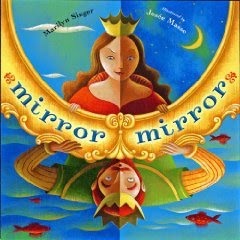 Mirror Mirror: a book of reversible verse by Marilyn Singer, illustrated by Josée MasseDutton Children's Books, 2010Fairy tales are told from two perspectives using the same poem, but read in reverse the second time. Deceptively simple premise, yes? Well, Marilyn Singer has come up with over a dozen pairs of poems that tell parts of fairy tales using the same words and the same lines, in a style she calls reverso. In her words: "When you read a reverso down, it is one poem. When you read it up, with changes allowed only in punctuation and capitalization it is a different poem" (last page of unpaginated book). Amazingly, it really works. I'm glad I read this book today for a second time, because when I read it for the first time last week I wasn't a huge fan of it: it struck me as gimmicky and some of the poems felt awkward. I must have been tired or in a foul mood because today I really enjoyed it. Admittedly, some of the poems don't flow as nicely as I would have liked, but when it clicks all is well in the world. My favourites of the 14 reverso pairs are The Doubtful Duckling and Longing for Beauty, both of which deal with the characters' emotions (the Ugly Duckling and Beauty and the Beast, respectively) as opposed to a description of events. In fact, the reversos in the book generally fall into one of those two categories: description of events and description of characters' feelings. Overall, I felt the ones that addressed emotions were more effective, but that may be my own bias. I must comment on the illustrations by Josée Masse because they are, in a word, spectacular. Each illustration is divided into two to reflect the reverso poems on the opposite page, and Masse creates beautiful links between each pair of illustrations. For example, Sleeping Beauty's skirt blends perfectly into the hills being climbed by the prince coming to save her. The illustrations are luminous, full of rich golds and greens and reds, and combine perfectly with the poems. For young students interested in poetry or fairy tales, this book will open their eyes to a challenging and fun style of writing.
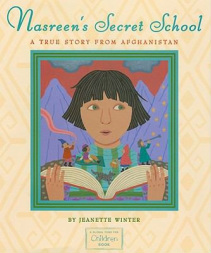 Nasreen's secret school by Jeanette Winter
Beach Lane Books, 2009
Nasreen and her grandmother live alone in Herat, Afghanistan, after Nasreen's father was taken away by Taliban soldiers and her mother has disappeared in an attempt to locate him. It has been many months and Nasreen has not spoken since her father was taken. Although the Taliban does not allow girls to go to school, Nasreen's grandmother wants her to learn about the world as she had so she finds out about a secret school for girls and takes Nasreen. Although it takes many more months, with the help of a friend Nasreen moves past her parents' disappearances and begins to learn.
This is not a light storybook, and Jeannette Winter does an admirable job explaining the Taliban regime and its ramifications on the daily lives of women in a succinct and easily understood manner. The recent history of Afghanistan is very briefly summarized in the first couple of pages, enough to provide context to the story, especially that the Taliban was a new regime and made radical changes to society. The arrival of the Taliban is correlated with a dark cloud settling over the city, and that cloud is visible in the majority of the illustrations. The author's note at the beginning reveals that the Taliban fell in 2001 but that danger still remains, and that girls going to school is still not accepted practice.
Not wholly dark, apart from the cloud Winter's illustrations are generally quite bright and patterned. Nasreen always wears the same clothing which makes it easier to pick her out from the crowd of girls at her school, as do her green eyes, and the pinks, oranges, and greens Winter often uses are a welcome lift from the text.
The idea of having a parent taken away and another disappearing is undoubtedly a scary subject for young children, especially as the book is based on a true story. As well, while the story ends on a happy note, within the confines of the book news of Nasreen's parents is never found and the Taliban is still, presumably, in power. For children who balk at the idea of parents being taken away this could prove to be a bit much, and so I would caution adults to read this book before presenting it to young children.
Nasreen's secret school provides a perspective not often seen in picture books: children who need to avoid mortal danger simply to have the opportunity to learn. Although perhaps scary for some children, it is a book that ends with hope and a positive look to the future, and would be an excellent read-aloud to raise awareness of the continuing plight of women in Afghanistan for older children and teens as well.
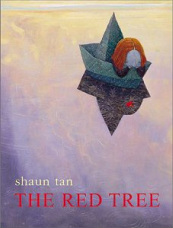 The red tree by Shaun TanSimply Read Books, 2003I unabashedly adore Shaun Tan. It should be noted that this was not the case before I read The red tree. Granted, I think his The arrival is a work of genius, but The red tree spoke to me so vividly that I would probably be struck dumb if ever I was lucky enough to meet him. The premise of The red tree is simple: a young girl wakes up and "...the day begins / with nothing to look forward to / and things go from bad to worse,"* until the end of the day when something remarkable happens. The execution, however, is anything but simple: the illustrations are stunning and the text is spare and poetic. The phrases Tan uses get right to the point, from "nobody understands" to "sometimes you just don't know what you are supposed to do." Hopelessness, fear, and yearning permeate this day in the small girl's life. The illustrations start out simply, with a depiction of the girl getting out of bed taking up about a fifth of the story's initial two-page spread. They do not stay simple however, and scenes straight out of a dark fantasy emerge. From desolate landscapes to massive mechanical dragons and ships in roiling seas, the small protagonist encounters a long sequence of unwelcoming environments. A lone red leaf is with her throughout her day, something that I did not catch until I read the book a second time. Having read two of Shaun Tan's other books - The arrival (2007)and Tales from outer suburbia (2008) - it is fascinating to see how some visual elements from The red tree are also found in those books. For example, one of the earliest scenes in The red tree shows the girl with a large old-fashioned submarine helmet on her head, which is very similar to the helmet found on the cover of an edition of Tales from outer suburbia. While the human characters in The arrival are more realistic in their features, the alien space and objects in The red tree have similarities to the atmosphere in The arrival. This is a book that is, arguably, for older students. While it is as dark as it is beautiful, I would not shy away from having it in an elementary library. However, I believe that older students, especially teens, would get a lot more out of The red tree. As an adolescent I remember often feeling hopeless, misunderstood, and like nothing good would ever happen to me, and anecdotal evidence suggests that many others would agree. The red tree is a beautiful, poignant book that I will purchase for the school libraries I manage, and a thousand thanks to my professor for the recommendation. *Another unpaginated picture book! These lines are the first three lines of the book, but all other quotes in this review will not be given a page reference.
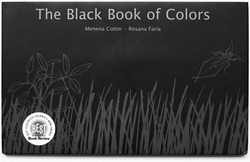 The black book of colors by Menena Cottin and Rosana Faria, translated by Elisa Amado
Groundwood Books/House of Anansi Press, 2006
More than any other book I've come across - certainly more than any other picture book I've encountered - The black book of colors gives those of us with the ability to see an idea of how we might perceive colours if we were blind. Printed entirely on black paper, a boy named Thomas describes what colours mean to him, beginning with, "Thomas says that yellow tastes like mustard, but is as soft as a baby chick's feathers."* A Braille translation is provided above the printed white text, and the page opposite the text and the Braille is comprised of an embossed representation of how Thomas interprets the color, in this case delicate feathers. The reader is able to read the text, feel how the same words are written in Braille, and feel the raised images.
Image from: http://erin-thefoolscapflyer.blogspot.com/2009/08/black-book-of-colors.html This isn't just a gimmick either, as the text is spare and evocative. Some connections seem more likely than others, such as brown smelling like chocolate, and other colours are very personal to Thomas, as with black feeling like his mother's hair falling on his face when she hugs him. The black book of colors takes colours into the realm of having meaning and associated emotion, well past mere visual processing of the electromagnetic spectrum.
*Book is not paginated.
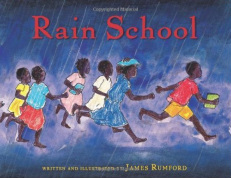 Rain school by James Rumford
Houghton Mifflin Harcourt, 2010
It is the first day of school for Thomas and the other children of his village in Chad. When Thomas and the other children arrive there is no school building, just a teacher. The students' first lesson is how to build a school from the ground up, as they do every year after the summer rainy season.
Rain school stems directly from James Rumford's experience as a Peace Corps volunteer in Chad and his knowledge shows. Many details, from the patterns of fabric to the local fauna, make it evident that he is familiar with the country. The backgrounds of the illustrations are predominantly shades of yellow and orange, which not only gave me a sense of heat but also provide an appropriately joyous atmosphere to the book.
It is difficult for many of us to imagine having to build a school every September in order to have a place to learn or teach. However, people in many parts of the world are not as lucky as we are and need to go above and beyond simply to learn, and Rain school is a delightful introduction to the topic.
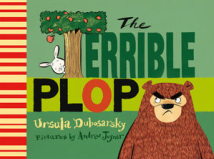 The Terrible Plop by Ursula Dubosarsky with pictures by Andrew Joyner
Penguin Books for Children, 2009
The Terrible Plop is a book that starts
With a PLOP that trembles the rabbits' hearts.
They start to run and when they do
The forest critters follow, too.
While all the creatures run away
The big brown bear decides to stay.
What will happen when the bear goes to see
The PLOP that's causing everyone to flee?
In rollicking text that has a pleasing rhyme,
This book is joy at read-aloud time.
A touch of mystery, colourful art,
and humour set Terrible Plop apart.
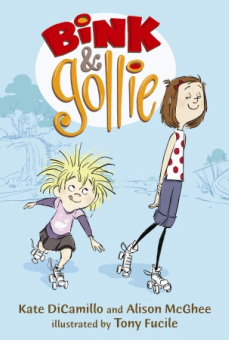 Bink & Gollie by Kate DiCamillo and Alison McGhee, illustrated by Tony FucileCandlewick, 2010 Bink, a small girl with wild blonde hair, lives in a homey little cottage while Gollie, a tall brunette, lives in a tidy modern home in a tree (yes, a treehouse!). Through the course of three short chapters, the girls have small adventures which demonstrate the ups and downs of friendship. Bink & Gollie is absolutely delightful. The girls, apparent best friends and near-constant companions, seem to have little in common. Gollie has an outwardly calm demeanor and uses a charmingly old-fashioned vocabulary - '"Greetings, Bink," said Gollie. "I long for speed"' (p. 3). Bink, on the other hand, has a disheveled look about her and her actions are propelled by emotion and other drives, such as hunger. Together, they work to find compromises when they have disagreements and do their best to see one another's perspective. The illustrations are as charming as the characters themselves. Tony Fucile uses colour to accentuate components in his predominantly grey-scale drawings, from signs in store windows to a new goldfish. Bink and Gollie themselves are always in full colour, and one touch I especially enjoyed was the smudge of orange to indicate Fred in the frozen pond on the final page. Although there are many details within the illustrations (like Gollie's treehouse, which I now covet), care was taken not to detract from the two girls. A wonderful collaboration (which makes me wonder if DiCamillo is more like Bink and McGhee is more like Gollie, or vice versa*) with an endearing result. *Read this article to find out!
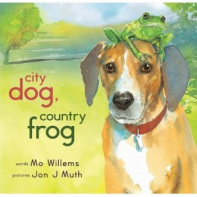 City dog, country frog by Mo Willems, illustrated by Jon J. Muth
Hyperion, 2010
When City Dog arrives for a visit to the country in springtime, he heads off for a gleeful leash-free run and encounters Country Frog. When asked why he is sitting on a rock, Country Frog replies that he is waiting for a friend, but that City Dog will do. Thus begins a friendship that lasts through the seasons.
Picture books of friendship don't come much more poignant than this. Mo Willems is a master of subtly injecting emotion into the play of words and images in his books, and combining his words with Jon J. Muth's expressive watercolour illustrations is a match made in heaven. The colours capture the essence of the four seasons and the animals have obvious personalities. City Dog's tail and ears are consistently perfect, and in the image below his confusion at Country Frog's absence is evident. The illustrations extend Willems' carefully selected words and, in keeping with the origins of the word, beautifully illuminate them.
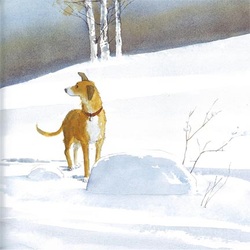 Image from: http://32pages.ca/2011/01/07/a-dog-a-frog-and-an-apology/ I'm not going to lie: I've read this book three times and I've been misty-eyed on every occasion. You see, Country Frog doesn't survive past autumn and City Dog persists in waiting for him to reappear into the following spring. (Lest you think the book ends on a sad note, rest assured that City Dog befriends another country creature.) Bittersweet and beautiful it most certainly is, and well worth a look.
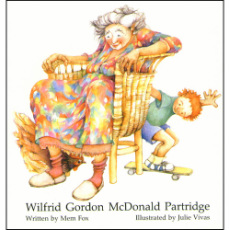 Wilfrid Gordon McDonald Partridge by Mem Fox, illustrated by Julie Vivas
Kane Miller, 1984
Wilfrid Gordon McDonald Partridge is four years old and lives next door to an "old people's home," where he has numerous friends. He overhears that his best friend Miss Nancy lost her memory, but Wilfrid doesn't know what memory is. When he asks all his friends at the home about it, he gets a variety of answers that he interprets in his own way to help Miss Nancy.
What a truly lovely book. It contains what I consider to be the essential components of a wonderful picture book: a deceptively simple story, concisely told and relatable, with gorgeous illustrations. Mem Fox and Julie Vivas certainly deliver that here, and the collaboration is such that the sum of the writing and illustrations is greater than the two parts. Every word is absolutely necessary, and each illustration is luminous and expressive.
In my experience, there are not many picture books that address intergenerational friendships. In fact, this is the only one I've come across in which the relationships depicted are purely friendships and the child is not related to any of the elderly characters. It is refreshing and wonderful and I hope there are more like it that I simply haven't found yet.
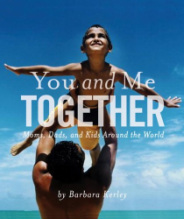 You and me together: Moms, Dads, and kids around the world by Barbara KerleyNational Geographic Society, 2005With spare, rhythmic text and gorgeous photographs from all around the world, You and me together looks at the common experiences shared by parents and children regardless of culture, language, nationality, or religion. This is an absolutely gorgeous book. The photos all have a parent with one or more children partaking in activities described by the text, from playing with a ball to riding ponies to just having a chat. Each photo in the book (including the cover image) has a brief caption at the back explaining where the photograph was taken and something interesting about the subjects or event depicted in the image. Although North America is the continent depicted most often in the book, the images cover all continents (except Antarctica). Although one spread in particular that shows a young Karen girl gazing at her guitar-playing mother with an expression of absolute adoration just about undoes me, You and me together is chock full of lovely everyday moments between children and their parents. Most of the children depicted in the images fall within the 4- to 8-year-old age group, which is likely the target child audience. An outstanding book to demonstrate for young children the similarities and differences between cultures.
|




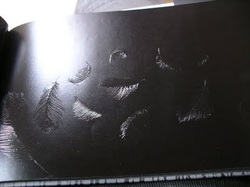







 RSS Feed
RSS Feed